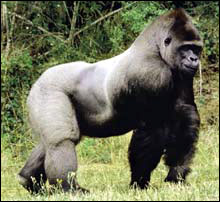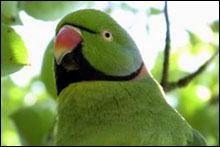'Global extinction crisis' as species join Red List
|
Gorillas, China's baiji dolphin, Asian vultures and Pacific corals on
Wednesday joined the list of species hurtling to oblivion as the World
Conservation Union (IUCN) warned of a fast-track "global extinction
crisis".
In an update of its famous Red List of biodiversity, the Swiss-based IUCN said it had identified 41 415 species at threat. Of these, 16 306 species -- equivalent to 39% of the total -- are in danger of extinction, 188 more than last year.
"The invaluable efforts made so far to protect species are not enough," said IUCN director general Julia Marton-Lefevre. "The rate of biodiversity loss is increasing and we need to act now to significantly reduce it and stave off this global extinction crisis."
The Red List is one of the most authoritative markers of biodiversity. It is compiled by conservationists, who apply strict criteria to evaluate sightings of the species and the state of its habitat.
Threat risk is graded according to a descending order of categories: "extinct, or extinct in the wild"; "critically endangered, endangered and vulnerable", applying to degrees of threats of global extinction; "near threatened"; "least concern", meaning that there is a low risk of extinction; and "data deficient", meaning that information is lacking to make an assessment.
One in four mammals, one in eight birds, one-third of amphibians and 70% of the world's assess plants are in jeopardy, the IUCN said.
The new Red List, unveiled in Paris, placed the spotlight on these species:
- The Yangtze river dolphin, or baiji (Lipotes vexillifer), hit by pollution, fishing, river traffic and habitat destruction. A long search for the mammal last November and December proved fruitless, causing it be listed on Wednesday as "critically endangered (possibly extinct)".Its extinction can only be confirmed after further surveys are carried out; a possible sighting of the creature, reported last month, is being investigated by Chinese scientists, the IUCN said.
- The western gorilla (Gorilla gorilla), which moves from endangered to critically endangered. Researchers have uncovered a sudden fall in numbers of the main subspecies, the western lowland gorilla, decimated by the bushmeat trade and ebola virus.
- Sumatran orangutans (Pongo abelii) are critically endangered, Bornean (Pongo pygmaeus) endangered: unchanged after a new survey. About 7 300 Sumatran orangutans live in the wild while there are probably fewer than 45 000 to 69 000 in Borneo. Both are threatened by habitat loss, to palm oil plantations in Borneo and to logging in Sumatra.
- African and Asian vultures, five species of which have moved categories. They include Asia's red-headed vulture (Sarcogyps calvus), which moves from near threatened to critically endangered, its decline driven by fatal ingestion of the drug diclofenac, used to treat injured livestock.
- The gharial (Gavialis gangeticus), a crocodile native to India and Nepal, has moved from endangered to critically endangered due to threats to its habitat from dams, irrigation projects and artificial embankments. Its numbers have fallen from 436 breeding adults in 1997 to just 182 in 2006.
- Reptiles: In an exceptional move, the IUCN decided to add 723 turtles, snakes and other North American and Mexican reptiles to the Red List. They include a Mexican freshwater turtle called the Cuatro Cienegas slider (Trachemys taylori), endangered by habitat loss, and the Santa Catalina island rattlesnake (Crotalus catalinensis), persecuted by illegal collectors.
- The Banggai cardinal fish (Pterapogon kauderni), a species that is only found near the Banggai islands near Sulawesi, Indonesia. The fish enters the Red List for the first time, listed as endangered. Demand from the aquarium trade means that 900 000 of these fish are being hauled out of the sea each year. "Ninety percent of this species' population has vanished in just a dozen years because of aquariums," said Jean-Christophe Vie, deputy head of the IUCN's species programme.
- Corals/ Seaweeds. Three corals from the Galapagos Islands in the Pacific are entering the Red List for the first time -- the first corals on the list and threatened by climate change and the sea warming effect known as El Niño. Also, 74 Galapagos seaweeds were added in 2007.
Only one species has moved to a lower category of threat: the Mauritius echo parakeet (Psittacula eques). Fifteen years ago, it was one of the world's rarest parrots; this year, though, it has moved from critically endangered to endangered.
"The improvement is a result of successful conservation action, including close monitoring of nesting sites and supplementary feeding, combined with a captive breeding and release programme," the IUCN said.
The IUCN said that the total number of extinct species stands at 785, and a further 65 are only found in captivity or in cultivation.
Estimates of the world's biodiversity vary between 10-million and 100-million species, with 15-million the most commonly cited figure. Only 1,7-million species have been described.
Sources: IUCN Species Programme, Sapa-AFP and Reuters News Service






